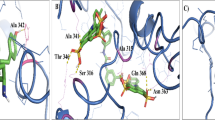Abstract
Complementary DNA, encoding the mitochondrial enzyme NADH-ubiquinone oxidoreductase subunit 5 (SmND5) of the human parasite Schistosoma mansoni was isolated by screening an S. mansoni cDNA library with a human androgen receptor (hAR) cDNA probe. The complete nucleotide and deduced aminoacid sequences of SmND5 were determined. Southern blot analysis revealed the occurrence of a single copy gene for SmND5 and by means of RT-PCR, it was shown that sex- and stage-specific expression of SmND5 occurred. In order to establish a functional relationship between the mitochondrial enzyme and the androgen receptor, the effects of testosterone were compared to those of classical respiratory chain inhibitors, using adult schistosome and beef heart submitochondrial particles. Physiological concentrations of testosterone were able to inhibit the maintenance of proton gradient across the mitochondrial membranes, as well as ATP synthesis. The steroid was found to be cytotoxic to the larvae, but not to adult schistosomes. A model is proposed to explain the observed in vivo testosterone-related differences in worm burdens, in experimental chronic infections.
Similar content being viewed by others
References
Cornford EM, Diep CP, Rowley GA: Schistosoma mansoni, S. japonicum, S. haematobium: Glycogen content and glucose uptake in parasites from fasted and control hosts. Exp Parasitol 56: 397–408, 1983
Cornford EM: Schistosoma mansoni, S. japonicum and S. haematobium: Permeability to acidic aminoacids and effect of separated and unseparated adults. Exp Parasitol. 59: 355–363, 1985
Tempone AJ, Bianconi ML, Rumjanek FD: The interaction of human LDL with the tegument of adult Schistosoma mansoni. Mol Cell Biochem 177: 139–144, 1997
Eloi-Santos S, Olsen NJ, Correa-Oliveira R, Colley DG: Schistosoma mansoni: Mortality, pathophysiology and susceptibility differences in male and female mice. Exp Parasitol 75: 168–175, 1992
Nakazawa M, Fantappié MR, Freeman GL Jr, Eloi-Santos S, Olsen NJ, Kovacas WJ, Secor WE, Colley DG: Schistosoma mansoni: Susceptibility differences between male and female mice can be mediated by testosterone during early infection. Exp Parasitol 85: 233–240, 1997
Beato M, Arnemann J, Chalepakis G, Slater E, Willman T: Gene regulation by steroid hormones. J Steroid Biochem 27: 9–14, 1987
Smither SR, Terry RJ: The infection of laboratory hosts with cercariae of Schistosoma mansoni and the recovery of adult worms. Parasitology 55: 695–700, 1965
Ramalho-Pinto FJ, Gazzinelli G, Howells RE, Mota-Santos TA, Figueiredo EA, Pellegrino J: Schistosoma mansoni: A defined medium for stepwise transformation of cercariae to schistosomula in vitro. Exp Parasitol 36: 360–372, 1974
Altschul SF, Madden TL, Schäffer AA, Zhang Z, Miller W, Lipman D: Gapped BLAST and PSI-BLAST: a new generation of protein database search programs. Nucl Acids Res 25: 3389–3402, 1997
Sambrook J, Fritsch EF, Maniatis T: In: Molecular Cloning, A Laboratory Manual. ColdSpring Harbor Laboratory Press, 1989
Cunha VMN, Souza W, Noël F: A Ca2+ stimulated, Mg2+ dependent ATPase activity in subcellular fractions from Schistosoma mansoni. FEBS Lett 241: 65–68, 1988
Matsuno-Yagi A, Hatefi Y: Studies on the mechanism of oxidative phosphorylation; flow force relationships in mitochondrial energy-linked reactions. J Biol Chem 262: 14158–14163, 1987
Perlin DS, Kasamo J, Brooker RJ, Slayman CW: Electrogenic H+ translocation by the plasma membrane ATPase of Neurospora. J Biol Chem 259: 7884–7892, 1984
de Meis L: Approaches to studying the mechanisms of ATP synthesis in sarcoplasmic recticulum. Meth. Enzymol 157: 190–206, 1988
Vivat V, Gofflo D, Garcia T, Wurtz JM, Bourguet W, Philibert D, Gronemeyer H: Sequences in the ligand-binding domain of the human androgen and progesterone receptors which determine their distinct ligand identities. J Mol Endocrinol. 18: 147–160, 1997
Lanz RL, Rusconi S: A conserved carboxi-terminal sub-domain is important for ligand interpretation and transactivation by nuclear receptors. Endocrinology 135: 2183–2195, 1994
Tomarev SI, Piatigorski J: Lens crystallins of invertebrates – Diversity and recruitment from detoxification enzymes and novel proteins. Eur J Biochem 235: 449–465, 1996
Orlean P, Albright C, Robbins PW: Cloning and sequencing of the yeast gene for dolichol phosphate mannose synthase, an essencial protein. J Biol Chem. 263: 17499–17507, 1988
Madani ND, Malloy PJ, Rodriguez-Pombo P, Krishnan AV, Feldman D: Candida albicans estrogen-binding protein gene encodes an oxidoreductase that is inhibited by estradiol. Proc Nat Acad Sci USA 91: 922–926, 1994
Iglesias T, Caubin J, Zaballos A, Bernal J, Muñoz A: Identification of a mitochondrial NADH dehydrogenase subunit 3 (ND3) as a thyroid hormone regulated gene by whole genome PCR analysis. Biochem Biophys Res Commun. 210: 995–1000, 1995
Cornwall GA, Orgebin-Crist MC, Hann SR: Differential expression of the mouse mitochondrial genes and the mitochondrial RNA-processing endoribonuclease RNA by androgens. Mol Endocrinol 6: 1032–1042, 1992
Yelding KL, Tomkins GM, Munday JS, Cowley IJ: The effect of steroids on electron transport. J Biol Chem. 235: 3413–3416, 1960
Vallejos RH, Stoppani OM: Site-specific effects of steroids on mitochondrial metabolism. Biochim Biophys Acta 131: 295–309, 1967
Varrichio F: Inhibition of mitochondrial respiration by progesterone and azasteroid. Arch Biochem Biophys. 121: 187–193, 1967
Forman BM, Tzanelli I, Choi HS, Chen J, Sinha D, Seol W, Evans RM, Moore DD: Androstane metabolites bind to and deactivate the nuclear receptor CAR-b. Nature 395: 612–615, 1998
van Oordt BE, van den Heuvel JM, Tielens AG, van den Bergh SG: The energy production of the adult Schistosoma mansoni is for a large part aerobic. Mol Biochem Parasitol. 16: 117–126, 1985
Author information
Authors and Affiliations
Rights and permissions
About this article
Cite this article
Fantappié, M.R., Galina, A., de Mendonça, R.L. et al. Molecular characterisation of a NADH ubiquinone oxidoreductase subunit 5 from Schistosoma mansoni and inhibition of mitochondrial respiratory chain function by testosterone. Mol Cell Biochem 202, 149–158 (1999). https://doi.org/10.1023/A:1007057903390
Issue Date:
DOI: https://doi.org/10.1023/A:1007057903390




